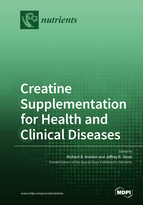Creatine Supplementation for Health and Clinical Diseases
A special issue of Nutrients (ISSN 2072-6643). This special issue belongs to the section "Sports Nutrition".
Deadline for manuscript submissions: closed (31 December 2021) | Viewed by 478907
Special Issue Editors
Interests: exercise physiology; sports nutrition; performance enhancement; weight loss; women's health
Special Issues, Collections and Topics in MDPI journals
Interests: nutrition; ergogenic aids; dietary supplements; body composition; muscle fatigue
Special Issues, Collections and Topics in MDPI journals
Special Issue Information
Dear Colleagues,
Creatine supplementation is one of the most studied and effective ergogenic aids for athletes. The multifaceted mechanisms by which creatine exerts its beneficial effect include increasing anaerobic energy capacity, increasing protein synthesis, and decreasing protein breakdown, leading to increased muscle mass and physical performance. While these well-recognized creatine effects benefit the athlete, creatine may also serve as a potential clinical and therapeutic supplementary treatment to conventional medical interventions. Several studies have examined the effects on conditions such as diabetes, sarcopenia, osteoporosis, cancer, rehabilitation, and pulmonary and cardiovascular health. This Special Issue aims to provide comprehensive reviews of creatine supplementation effects for health and clinical diseases.
Dr. Richard B. Kreider
Dr. Jeffrey R. Stout
Guest Editors
Manuscript Submission Information
Manuscripts should be submitted online at www.mdpi.com by registering and logging in to this website. Once you are registered, click here to go to the submission form. Manuscripts can be submitted until the deadline. All submissions that pass pre-check are peer-reviewed. Accepted papers will be published continuously in the journal (as soon as accepted) and will be listed together on the special issue website. Research articles, review articles as well as short communications are invited. For planned papers, a title and short abstract (about 100 words) can be sent to the Editorial Office for announcement on this website.
Submitted manuscripts should not have been published previously, nor be under consideration for publication elsewhere (except conference proceedings papers). All manuscripts are thoroughly refereed through a single-blind peer-review process. A guide for authors and other relevant information for submission of manuscripts is available on the Instructions for Authors page. Nutrients is an international peer-reviewed open access semimonthly journal published by MDPI.
Please visit the Instructions for Authors page before submitting a manuscript. The Article Processing Charge (APC) for publication in this open access journal is 2900 CHF (Swiss Francs). Submitted papers should be well formatted and use good English. Authors may use MDPI's English editing service prior to publication or during author revisions.
Keywords
- creatine
- neurodegeneration
- muscular diseases
- metabolic dysfunction
- aging
- cognition
- rehabilitation








